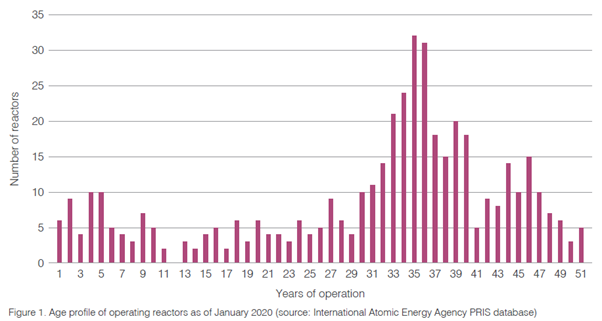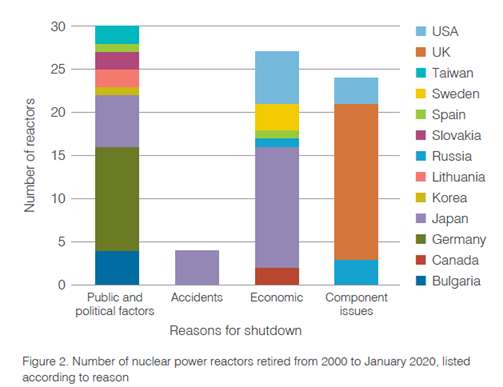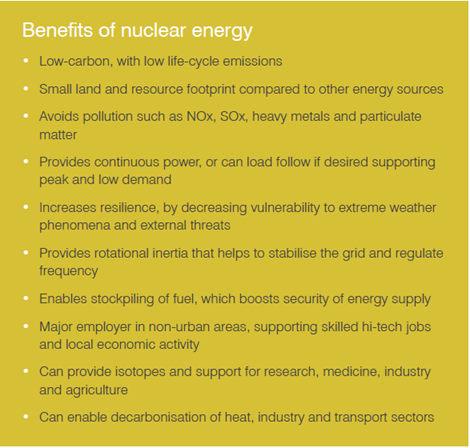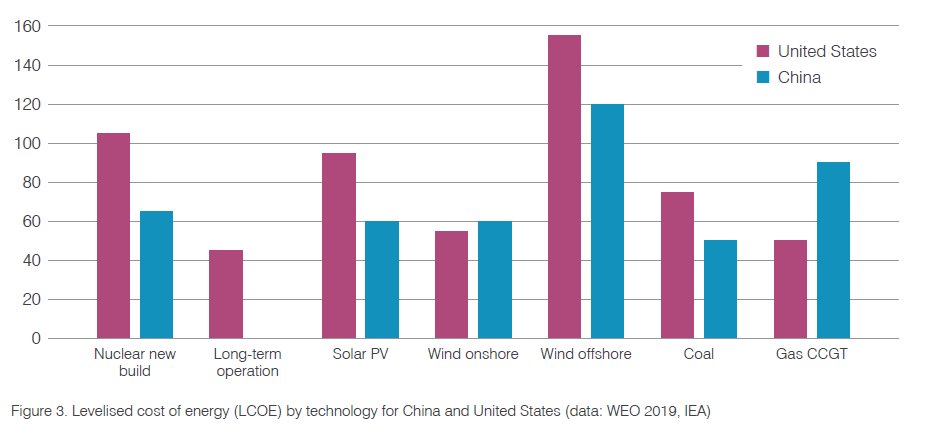Some are calling the closure of Fessenheim nuclear power plant a tragedy. But why? After all it was France’s oldest plant. When is a reactor retirement premature rather than reasonable? What are the reasons so many nuclear plants seem to be closing ‘early’? Time for a thread 1.
2. Today’s thoughts on the topic of the long term operation (LTO) of nuclear power plants are based on this new @worldnuclear report I had the privilege to be involved with https://www.world-nuclear.org/our-association/publications/technical-positions/the-enduring-value-of-nuclear-energy-assets.aspx">https://www.world-nuclear.org/our-assoc... Big shout out to my ex-colleague Mohammad Rababah and WNA’s LTO taskforce members
3. This report was inspired by the @IEA report Nuclear Power in a Clean Energy System. https://www.iea.org/reports/nuclear-power-in-a-clean-energy-system">https://www.iea.org/reports/n... As I have noted before, IEA has a very clear position on the importance of nuclear energy – at least in terms of keeping existing plants operating as long as possible
4. In fact IEA Executive Director @IEABirol is on the record saying, “Lifetime extensions for nuclear plants are not only a cost-effective solution, but also keep our climate targets alive,” “They are the most urgent policy challenge today.” https://www.ft.com/content/c141fdf4-80a8-11e9-b592-5fe435b57a3b">https://www.ft.com/content/c...
5. Last year witnessed a historic milestone with the first nuclear power reactor reaching 50 years of operation. Tarapur unit 1 in India holds that honour, but was soon joined by unit 2, and reactors at the Beznau plant in Switzerland, Nine Mile Point and Ginna in USA.  https://abs.twimg.com/emoji/v2/... draggable="false" alt="🎂" title="Geburtstagskuchen" aria-label="Emoji: Geburtstagskuchen">
https://abs.twimg.com/emoji/v2/... draggable="false" alt="🎂" title="Geburtstagskuchen" aria-label="Emoji: Geburtstagskuchen">
6. Another major milestone in nuclear longevity also occurred in 2019 with the first nuclear power reactors, Turkey Point units 3 and 4, being licensed to operate for 80 years. I’ll say that again. 80 years! This is truly remarkable https://www.world-nuclear-news.org/Articles/Turkey-Point-licensed-for-80-years-of-operation">https://www.world-nuclear-news.org/Articles/...
7. In the past, the nuclear industry used to routinely talk about reactor lifespans of 30 – 40 years. The basis for this is not 100% clear to me, but seemed to be due to conservative estimates for when key components might deteriorate as well as investment amortisation
8. This time frame worked its way into key policy and regulatory considerations. 40 years was the length of a reactor license set by the US NRC. But over the years it became clear that this was simply too conservative. The US NRC started approving plants for 60 years, and now 80.
9. Critical component degradation was not happening at the rate initially feared. With maintenance and periodic upgrades it was proving possible to make plants safer over time. It began to dawn that there might not be any preset technical limit to the lifespan of a reactor.
10. Now not all nuclear plants will prove technically capable of achieving lengthy lifespans. Safety/aging assessments need to be carried out on a case by case basis. Also some reactor technologies – notably those with graphite moderators – suffer more severe life limiting issues
11. However the potential for the vast majority of today’s global fleet of existing nuclear power reactors to achieve long term operations has been clearly demonstrated. A good thing – since most reactors are over 30 years old now
12. And yet in recent years there have been many incidences of nuclear power plants closing. These have certainly not all been related to component age or regulator approved safety. Additional reasons include political/public acceptance, economics, and of course accidents
13. IMHO, the most unique part of the new report is this graph. Mohammad and I went over every nuclear power reactor closure in the last 20 years, examining available media and reports to assign the main reasons for closure.
14. Getting back to the original question – when is it ok to close a nuclear reactor? IMHO, component aging and poor economics are good reasons. But this should be as determined by the regulator and the nuclear plant owner/operator
15. But a government intervention or pre-set lifespan in policy that forces safe nuclear plants to close down is a clear example of a ‘premature’ closure. Take a look at the largest column of figure 2. Unfortunately it turns out there’s EVEN MORE to it than that.
16. Most nuclear power reactors don’t shut down for a single clearly defined reason – there is always a mixture of contributing factors. On deeper examination it is especially obvious that most of the reactor closures listed as ‘economic’ in fact reflect deeper political issues.
17. Recent Japanese closures are all listed as economic but reflect decision by utilities not to pursue regulatory mandated upgrades and the restart of certain reactors idled after the Fukushima Daiichi nuclear accident. There is clearly a strong public/political dimension here
18. Government don’t always effect policy by decree. The recent closure of reactors in EU countries such as Sweden and Spain has been heavily influenced by punitive taxation other stealth policies. See for example https://www.neimagazine.com/features/featureswedens-silent-phaseout-5930567/">https://www.neimagazine.com/features/... ht @JohnCHLindberg
19. In the USA most recent reactor closures have been driven by the emergence of the super-cheap shale gas resource, but the underlying market structure and especially the lack of financial recognition for the non-power benefits of nuclear have also played a huge role.
20. Side note – this is my personal list of non-power and economic benefits of nuclear energy refined over the years. The non-power benefits of nuclear energy are real and substantial
21. It should also be noted that, in most markets, LTO of existing nuclear plants is hands down one of the most cost effective options for generating low carbon electricity, and the IEA expects it to remain so for decades to come.
22. Side note: I’m a strong believer that the costs of new nuclear will fall in places like Europe and USA if countries commit to future projects. People interested in this topic should definitely tune into @OECD_NEA a webinar taking place tomorrow https://twitter.com/OECD_NEA/status/1273991847598329857">https://twitter.com/OECD_NEA/...
23. To repeat, once you account for market failures and government attempts to close nuclear plants by stealth, it becomes clear that almost all recent reactor closures listed as economic and political public acceptance are in fact premature reactor closures
24. This actually covers the main points that I wanted to make in this thread, BUT THERE IS MORE IN THE REPORT. I urge you to read it. It’s mercifully short! That link again https://www.world-nuclear.org/our-association/publications/technical-positions/the-enduring-value-of-nuclear-energy-assets.aspx">https://www.world-nuclear.org/our-assoc... But here are a couple more points...
25. Sometimes the LTO of existing nuclear plants can actually be competition for nuclear new build. This is quite divisive actually. For as much as the nuclear industry wants to see plants operating for as long as possible, most in the industry want to see new build even more!
26. We concluded “building new nuclear plants is essential both to the long-term prospects of the nuclear industry and for meeting climate goals. LTO should serve as a bridge to new build, helping to preserve core industry competencies and developing project experience…”
27.The second part of the report provides a very high level summary of what needs to be done in order to successfully achieve nuclear LTO. This is only a short list. Other publications, notably IAEA ones, are far more comprehensive
28. I’ll just highlight one point from this section. Which new technologies were voted most likely to play an important role in helping to achieve LTO? 1) Plant Digitalisation 2) Additive manufacturing, 3) artificial intelligence, 4) Robotocs, 5) advanced nuclear fuels
29. Or to rephrase, innovation is not reserved only for advanced reactor techs. It is also integral to achieving the LTO of existing nuclear plants. Far from these plants being out of date as is so often portrayed by opponents, there is significant opportunity for modernization
30.Thanks for reading for the end. If you want more read @W_Nuclear_News for a Perspective to be provided by the taskforce members https://www.world-nuclear-news.org/Articles/LTO-essential-to-cost-effective-climate-benefits-o">https://www.world-nuclear-news.org/Articles/...

 Read on Twitter
Read on Twitter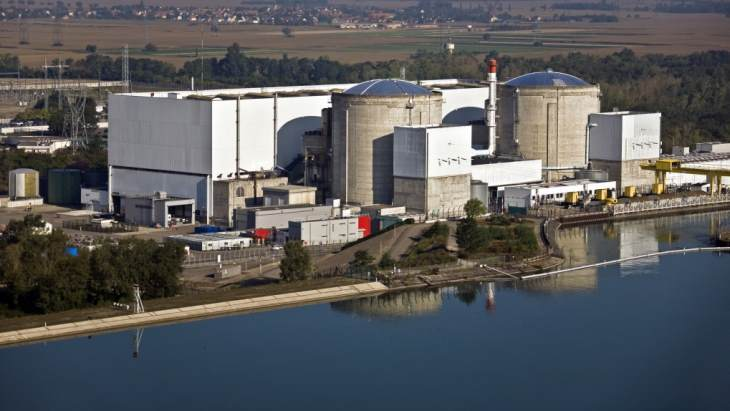
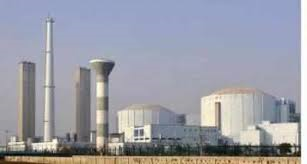 " title="5. Last year witnessed a historic milestone with the first nuclear power reactor reaching 50 years of operation. Tarapur unit 1 in India holds that honour, but was soon joined by unit 2, and reactors at the Beznau plant in Switzerland, Nine Mile Point and Ginna in USA. https://abs.twimg.com/emoji/v2/... draggable="false" alt="🎂" title="Geburtstagskuchen" aria-label="Emoji: Geburtstagskuchen">">
" title="5. Last year witnessed a historic milestone with the first nuclear power reactor reaching 50 years of operation. Tarapur unit 1 in India holds that honour, but was soon joined by unit 2, and reactors at the Beznau plant in Switzerland, Nine Mile Point and Ginna in USA. https://abs.twimg.com/emoji/v2/... draggable="false" alt="🎂" title="Geburtstagskuchen" aria-label="Emoji: Geburtstagskuchen">">
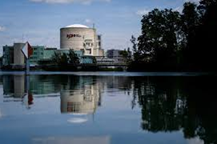 " title="5. Last year witnessed a historic milestone with the first nuclear power reactor reaching 50 years of operation. Tarapur unit 1 in India holds that honour, but was soon joined by unit 2, and reactors at the Beznau plant in Switzerland, Nine Mile Point and Ginna in USA. https://abs.twimg.com/emoji/v2/... draggable="false" alt="🎂" title="Geburtstagskuchen" aria-label="Emoji: Geburtstagskuchen">">
" title="5. Last year witnessed a historic milestone with the first nuclear power reactor reaching 50 years of operation. Tarapur unit 1 in India holds that honour, but was soon joined by unit 2, and reactors at the Beznau plant in Switzerland, Nine Mile Point and Ginna in USA. https://abs.twimg.com/emoji/v2/... draggable="false" alt="🎂" title="Geburtstagskuchen" aria-label="Emoji: Geburtstagskuchen">">
 " title="5. Last year witnessed a historic milestone with the first nuclear power reactor reaching 50 years of operation. Tarapur unit 1 in India holds that honour, but was soon joined by unit 2, and reactors at the Beznau plant in Switzerland, Nine Mile Point and Ginna in USA. https://abs.twimg.com/emoji/v2/... draggable="false" alt="🎂" title="Geburtstagskuchen" aria-label="Emoji: Geburtstagskuchen">">
" title="5. Last year witnessed a historic milestone with the first nuclear power reactor reaching 50 years of operation. Tarapur unit 1 in India holds that honour, but was soon joined by unit 2, and reactors at the Beznau plant in Switzerland, Nine Mile Point and Ginna in USA. https://abs.twimg.com/emoji/v2/... draggable="false" alt="🎂" title="Geburtstagskuchen" aria-label="Emoji: Geburtstagskuchen">">
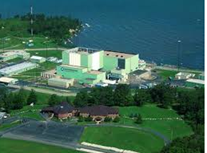 " title="5. Last year witnessed a historic milestone with the first nuclear power reactor reaching 50 years of operation. Tarapur unit 1 in India holds that honour, but was soon joined by unit 2, and reactors at the Beznau plant in Switzerland, Nine Mile Point and Ginna in USA. https://abs.twimg.com/emoji/v2/... draggable="false" alt="🎂" title="Geburtstagskuchen" aria-label="Emoji: Geburtstagskuchen">">
" title="5. Last year witnessed a historic milestone with the first nuclear power reactor reaching 50 years of operation. Tarapur unit 1 in India holds that honour, but was soon joined by unit 2, and reactors at the Beznau plant in Switzerland, Nine Mile Point and Ginna in USA. https://abs.twimg.com/emoji/v2/... draggable="false" alt="🎂" title="Geburtstagskuchen" aria-label="Emoji: Geburtstagskuchen">">

